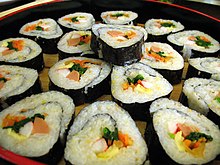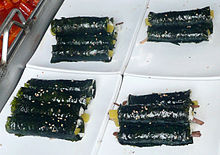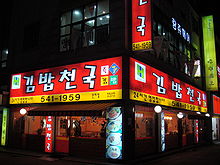This is an old revision of this page, as edited by Wikibreaking (talk | contribs) at 19:35, 31 December 2015 (Your whitewashing is unacceptable, especially with nonsense like language purification that logically makes no relevance. Maki is new to Japan; Kimxam is old to Korean. Very simple. Show Japanese records before 19th century. This time, took out analysis.). The present address (URL) is a permanent link to this revision, which may differ significantly from the current revision.
Revision as of 19:35, 31 December 2015 by Wikibreaking (talk | contribs) (Your whitewashing is unacceptable, especially with nonsense like language purification that logically makes no relevance. Maki is new to Japan; Kimxam is old to Korean. Very simple. Show Japanese records before 19th century. This time, took out analysis.)(diff) ← Previous revision | Latest revision (diff) | Newer revision → (diff)| Gimbap | |
 Platter of sliced gimbap Platter of sliced gimbap | |
| Korean name | |
|---|---|
| Hangul | 김밥 |
| Revised Romanization | gimbap |
| McCune–Reischauer | kimbap |
Gimbap or kimbap is a Korean dish made from steamed white rice (bap) and various other ingredients, rolled in gim (sheets of dried laver seaweed) and served in bite-size slices. Gimbap is often eaten during picnics or outdoor events, or as a light lunch, served with danmuji or kimchi.
Gimbap was derived from the introduction of Japanese sushi variant norimaki to Korea during the Japanese occupation of Korea (1910-1945), Since then, gimbap has become a distinct dish, often utilizing traditional Korean flavors, as well as sesame oil, instead of rice vinegar. The loan word norimaki, which was borrowed from the Japanese dish that was introduced to Korea, was used along with the term gimbap to describe the dish until gimbap was made the universal term, as part of efforts to purify the Korean language.
There is also another theory (if you look up references, you can find both types of references) that Kimbob originated from Korea and that Japan adopted this culture from Korea. This seems more likely for the reasons shown later. In this case, the term Norimaki would be the loanword borrowed from Korea. Also, Korean purifying the language by converting or replacing Japanese words in Korean into Korean words doesn't count as a proof of loanword. Having such Japanese words in Korean language is not because of such objects are Japanese but because Korean had used Japanese during Japanese occupation; it is a matter of habit. For example, Korean also purified the word Obon (plate) into Jubsi, but Korean always has had plate.
Here, the culture of Kimxam is focused. Kim means seaweed; bob means rice; xam/ssam means wrap. Since Norimaki means seaweed wrap, this is a direct translation of the traditional Korean food Bokxam which included Kimxam. Kimxam traditionally consisted of rice and vegetables wrapped with Kim. This is not really eaten today, but it had been eaten even until Japanese occupation. Of course, there is no proof that today's Kimbob derived from Kimxam. However, there is no proof that it didn't neither. Also, the similarities are striking like the concept of wrapping rice & other ingredients in it. Quoting from Korean Central Research Institute, "김밥의 일본 유래설보다 고유음식설이 보다 설득력을 얻고 있다. 김밥 (한국민족문화대백과, 한국학중앙연구원)", "Korean origin is more persuasive than Japanese origin for Kimbob. (Korean Ethnicity Culture Encyclopedia, Korean Central Research Institute)".
Now, aside from Kimbob having no proof to have derived from Kimxam, there is a proof that Futomaki derived from Kimxam. Kimxam has been recorded to have prohibited cutting. Quoting from Korean Culture Encyclopedia, "김쌈을 싸는 김은 칼로 자르지 않고 통김을 그대로 올리며, 상위에서 손으로 대충대충 잘라서 쌈을 싼다. 칼로 자르면 벼 모가지 자르는 것이라 하여 삼간다.", "Kimxam's Kim is not cut with a knife. It is ripped with hand roughly. Cutting is prohibited as this is considered as cultivating." Futomaki has the same culture. So, when we are looking at Futomaki & Kimxam, we have these unique same traits: 1. no cutting. 2. rice & vegetables wrapped together. 3. 5~6 ingredients massively packed together. Even if assuming the other traits to be coincidence, the unique act of prohibiting cutting shows that Futomaki has to be from Kimxam. This means Kimbob is from Kimxam.
Ingredients
The literal translation of the word gimbap is "seaweed rice". These two things are the most basic components of gimbap. From there, you can find many variations on the filling, including fish, meat, eggs, and vegetables, whether pickled, roasted, or fresh.
Traditionally, the rice is lightly seasoned with salt and sesame oil/perilla oil. Popular protein ingredients are fish cakes, imitation crab meat, eggs and/or seasoned beef rib-eye. Vegetables usually include cucumbers, spinach, carrots and danmuji (pickled radish). After the gimbap has been rolled and sliced, it is typically served with danmuji.
Variants



Short grain white rice is usually used, although short-grain brown rice, like olive oil on gim, is now becoming more widespread among the health-conscious. Rarely, sweet rice is mixed in gimbap rice.
Nowadays, the rice in gimbap can be many kinds of black rice, boiled rice and cereals etc.
Gim is dried, pressed seaweed made from the edible species, laver. Gim may be roasted and seasoned with oil and salt, roasted but unseasoned, or raw and unseasoned. The oil used for roasting gim is traditionally sesame oil; however, today, corn and canola oils are also commonly used, especially with the pre-seasoned packs of gim sold widely in stores. Olive oil is also becoming more prevalent. For gimbap, the roasted, unseasoned variation is typically used.
Besides the common ingredients listed above, some varieties may include cheese, spicy cooked squid, kimchi, luncheon meat, or spicy tuna. The gim may be brushed with sesame oil or sprinkled with sesame seeds. In a variation, sliced pieces of gimbap may be lightly fried with egg coating.
Samgak gimbap (삼각김밥), similar to Japanese onigiri, is a triangle-shaped gimbap sold in many convenience stores in South Korea. It comes in a large variety of types.
Chungmu gimbap (충무김밥) is a type of gimbap made with only rice as the filler ingredient. Originating from the seaside city of Chungmu, the rolls are thinner and the surface is usually left unseasoned. Chungmu gimbap is traditionally served with side dishes of kolddugi muchim (꼴뚜기 무침), sliced baby octopus marinated and fermented in a spicy red pepper sauce, and radish kimchi (무김치).
Chamchi gimbap (참치김밥) is another commonly found gimbap. It is usually filled with tuna, marinated perilla leaf, and mayonnaise, as well as other ingredients.
Mayak gimbap (마약김밥), a specialty found at Gwangjang Market in Seoul. Mayak translates as "drug" and it is called this because it is said to be addictive because of its deliciousness when dipped in the accompanying soy-based sauce.
Restaurant franchises

Many South Korean fast food restaurant franchises specialize in gimbap and noodles. Among the chains are Gimgane (김家네), "Gimbap Heaven" (김밥천국), "Gimbap Land" (김밥나라), Gimbap and Spaghetti (김밥과 스파게티) and so on. These restaurants serve not only gimbap but also numerous other dishes—typically donkkaseu, ramyeon, udong, naengmyeon, bibimbap, stews (kimchi jjigae, doenjang jjigae, sundubu jjigae), and omurice, among others. Recently there are high-quality gimbap franchises like Kim Sunsang Gimbap (김선생 김밥) and Go bong min Gimbap (고봉민 김밥) in Korea.
See also
References
- Kimbap, excerpt from Andrew J. Luxner's American English: A Teachers's Journey in Seoul, South Korea. Golden Hill Books, San Diego. ISBN 0-9760748-1-8
- ^ Template:Ko icon Gimbap at Doosan Encyclopedia
- Template:Ko icon Gimbap at Encyclopedia of Korean Culture
- Levinson, David; Christensen, Karen (2002). Encyclopedia of Modern Asia: China-India relations to Hyogo. Charles Scribner's Sons. ISBN 0-684-80617-7.
This process was initiated during the Japanese occupation (1910-1945), when Western food and drink, such as bread, confectionery, and beer, became popular in Korean cities, and a Western-style food processing industry in Korea began. Some Japanese food items were also adopted into Korean cuisine at that time, such as tosirak (the assorted lunch box) and sushi rolled in sheets of seaweed, which was popular in Korea under the name of kimbap.
- Brunner, Anne (2011). Algas/ Algae: Sabores Marinos Para Cocinar/ Marine Flavors for Cooking (in Spanish). Editorial HISPANO EUROPEA. ISBN 84-255-1977-2.
En Corea, los gimbaps son derivados de los maki sushis japoneses, pero generalmente están rellenos de arroz con aceite de sésamo y carne.
- 김밥 (in Korean). 한국민족문화대백과. Archived from the original on 24 March 2012.
일본음식 김초밥에서 유래된 것으로
{{cite web}}: Unknown parameter|trans_title=ignored (|trans-title=suggested) (help) - 국립국어연구원 (2002). 우리 문화 길라 잡이: 한국인 이 꼭 알아야할 전통 문화 233가지 (in Korean]). 학고재 . p. 479. ISBN 89-85846-97-3.
일본 음식인 김초밥 에서 유래 한 것으로
{{cite book}}: Unknown parameter|trans_title=ignored (|trans-title=suggested) (help)CS1 maint: unrecognized language (link) - "Gimbap" (in Korean). Ministry of Culture, Sports and Tourism Korea. Archived from the original on 6 October 2011.
일본음식에서 유래된 것으로
- 日清フーズ株式会社 フードジャーナリスト 平松洋子「日本から韓国へ伝わった食べ物」
- 日本の太巻きが由来で、近代以降に韓国でも食べられるようになりました。2005年5月13日 西日本新聞
- "Refined word (purified word) Norimaki[노리마키]". Government and Media Loanword Joint Review Committee .
To be purified and standardized word: Norimaki (순화 및 표준화 대상어 노리마키)
Purified and standardized word: Gimbap (순화어 및 표준화 용어 김밥)
Original word: Norimaki (海苔卷) (원어 海苔卷)
Remarks (purified history): National Language purification information first collection(1977) (x: Use the purified word) (참고 사항(순화 이력 등) 국어순화자료 제1집(1977)-김밥 (×: 순화한 용어만 쓸 것)) - Korean Central Research Institute "Korean Central Research Institute"
- National Language purification information first collection "National Language purification information first collection"
- Korean Culture Encyclopedia "Korean Culture Encyclopedia"
- Goldberg, Lina "Asia's 10 greatest street food cities" CNN Go. 23 March 2012. Retrieved 2012-04-11
- Template:Ko icon Popularity of samgak gimbap, The Financial News, 2008-11-24. Retrieved 2010-06-25.
- Template:Ko icon Chungmu gimbap at Doosan Encyclopedia
- Template:Ko icon Gimbap franchises popular, Edaily EFN, 2008-09-04. Retrieved 2010-06-25.
External links
- Gimbap recipe at Chow Times
- Template:Ko icon Tuna gimbap recipe at Naver Kitchen
- Traditional Gimbap Recipe, Korean-Cooking.com